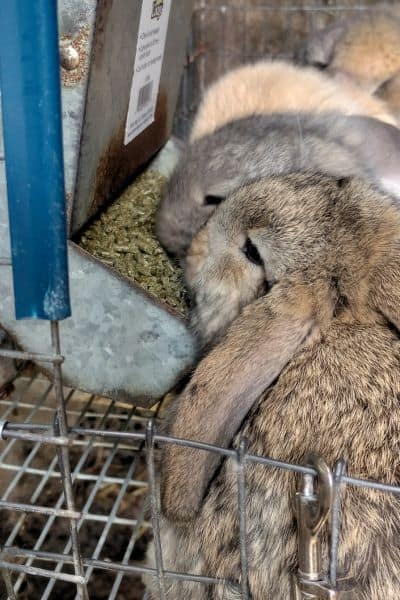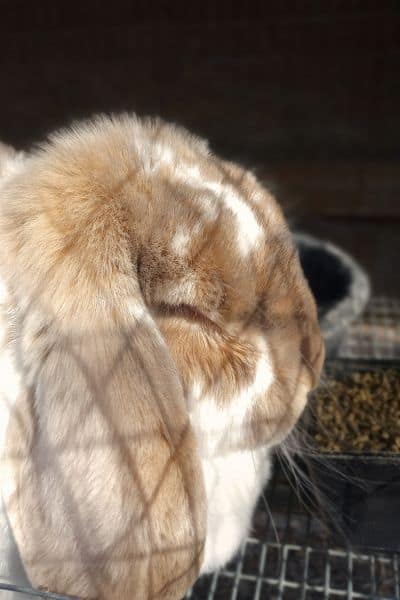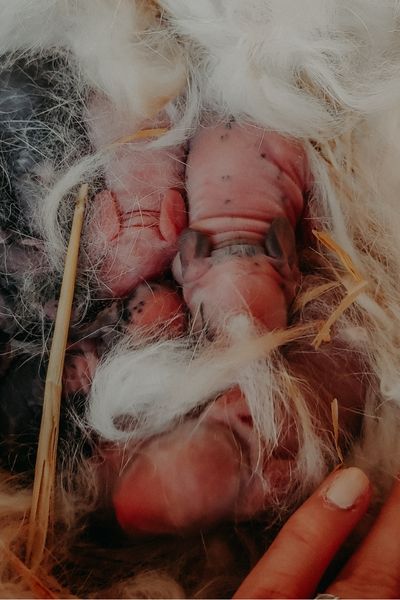Rabbits Giving Birth Process: What to look for and what to expect
Wondering what rabbits giving birth process looks like? Whether you think your mother rabbit is going to give birth soon. OR you are new to raising rabbits and you are trying to get ready for an upcoming litter you are doing the right thing by trying to learn all you can.
It is going to feel scary and you will hit some bumps in the road. Just take it one step at a time and just look at everything as a learning lesson.
No matter which direction things go just work through the problem or scenario knowing you did your best.
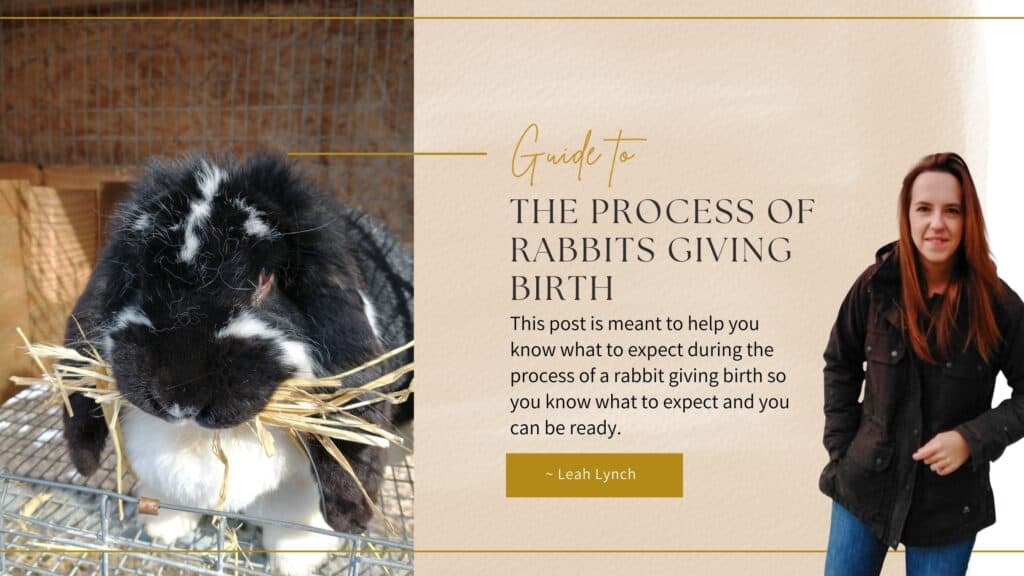
What Age Can A Rabbit Get Pregnant
A female rabbit (doe) can get pregnant as young as 12-16 weeks of age if she is a smaller breed. But the giant breeds mature much slower and it’s most likely that a giant breed rabbit could reach sexual maturity and could get pregnant around 5 months of age.
Now should they get pregnant before they are 3 months of age? Definitely not. Even for a small breed of rabbit that is too young.
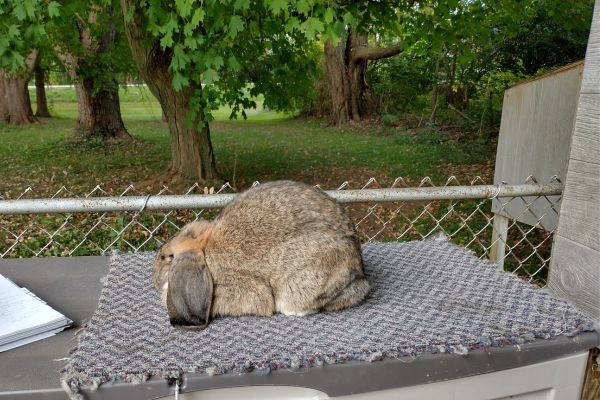
All rabbit breeds that are recognized by the ARBA have a minimum weight standard for the breed. As a general rule of thumb, you want your doe to reach that weight before breeding her.
The ideal age for a small breed of rabbit under 6 pounds for the breed standard seanure weight is 6 months of age.
For a giant breed like french lops, you want the mother rabbit to be 10 months old or her body weight to be the minimum weight of the breed standard for senior rabbits.
Steps To Prepare For Your Rabbit To Give Birth
If you think your rabbit is going to have babies let’s go through the steps to get her ready for them.
Tips For Feeding A Pregnant Rabbit
A doe needs to be eating 16-18% protein in her rabbit pellets or she will not be able to sustain feeding a litter. Rabbit feed that is not a commercial bag of feed and is aimed more at house pets tends to be 14% or less. I have had several people reach out because their litter was dying even though it seemed like the doe was feeding her babies. If you are feeding your rabbit mostly vegetables they are not getting near the protein they need. I am a huge advocate for only feeding your rabbits pellets and for this very reason.
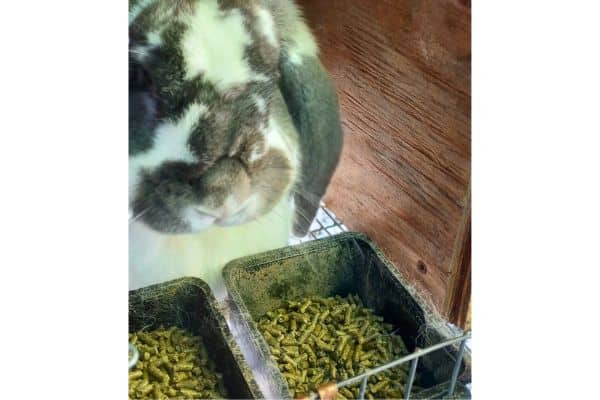
If you think your doe needs to be eating more pellets and she is pregnant then slowly try to shift her over to more pellets. But otherwise, DO NOT change brands of feed until the litter is born or until they are a week old. I have found that can cause a loss in an unborn litter.
Your doe will start to want more feed about a week before she gives birth to her litter. For all of my does I increase the amount they get just enough to the point where they clean it all up before I come and doe feeding the next day. Let her have what she wants but also try to avoid feed waste.
She may also seem to want more water which is totally fine. She is just drinking more which will help increase milk production once the litter is born.
Free Farm Goal Planner!!!
➡️Get my proven system for choosing your farm goals so you don’t get burnt out.
A Doe And Litter Size Rabbit Cage
If you are able you need to probably give the doe more space in her cage so she has room for a nest box in her cage and once the baby rabbits start getting mobile and leave the nest box she will need more room because the kits will stay with her until they are 6-8 weeks of age.
Depending on the breed a general guide for how big the cage should be for one doe and litter is if you could sit 6-8 of your adult-size rabbits in the cage comfortably.
Give Your Doe A Nest Box
Give your rabbit a nest box about 3 days before she is due. You don’t want to give her a box too soon because she may start using it as a toilet. Which is not uncommon for rabbits to do.
Rabbits need a nest box to contain their litter and keep the kits safe but they also need the box to help keep the kits warm and covered with straw and fur that the doe will pull from her dewlap and belly when she is close to delivery.
The kits should not be able to get out of the nest box until they are at least 2 weeks old.
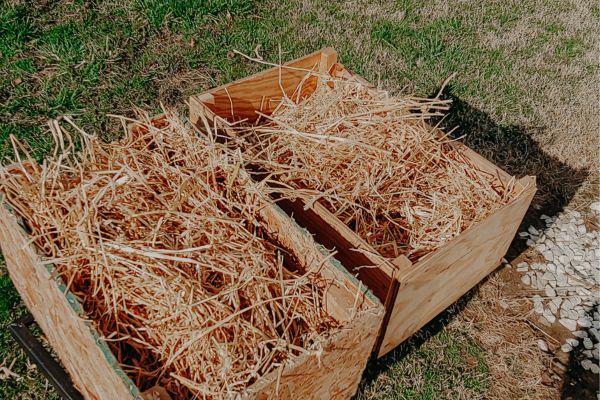
Some people have smaller nest boxes but if you have a large breed rabbit and she is stepping on her babies and they are dying you may need to get her a bigger box. I like to have my boxes be large enough so that two full-grown rabbits of my breed could sit next to each other in the box. This gives enough space for the doe to get in the box without landing right on top of the baby bunnies.
Straw is the best material for filing a nesting box because it holds together better and the does can make a nest much easier with it. I don’t use hay because it is moist and will not help as much when keeping the kits warm. It will also encourage the doe to eat the straw and not use it for a nest.
Wood boxes are best for a nest box because a doe will destroy a cardboard box when she starts exhibiting signs of nesting behavior. A plastic container is too easily knocked over and it is slick on the inside which could cause injury to your doe.
Signs Your Rabbit Is Pregnant
Knowing when a rabbit is pregnant is not an easy thing. Especially if it is the doe’s first time being bred. Here are the main signs of pregnancy by days after breeding.
5-7 Days after breeding: The first sign that a female rabbit is pregnant there will be a change in temperament. It is normal for a doe to get grumpy when she is in the mood to have a litter. If your rabbit had the “seasonal grouchies” before you bred her then in about 5 days to a week she should become calmer and even want more attention than normal.
Another thing that happens with pregnant rabbits is around this same time is her belly should become more firm almost like a half-filled water balloon.
10-20 Days after breeding: Not always but a pregnant doe will start to eat and want more food. If she is acting like she is starving to death and all her food is gone from the previous day give her about 1/4th more each day and see if that satisfies her. Just keep increasing it until she is happy but she has still cleaned up the food from the previous day. Ultimately let her have as much feed as she wants but the idea of adding a little more slowly is to avoid feed waste.
14 Days after breeding: This is not easy to do and the bigger the rabbit the harder it is. Around two weeks after your rabbit is bred you should be able to feel baby rabbits that are about the size of a seeded grape.
The thing to remember about this is the baby rabbits can be hiding up close to the momma’s spine or even low in the hips. Her turds can also be mistaken for babies as well. Personally, this is something I don’t bother with. I will know in two weeks whether or not she was pregnant so it’s less stressful for us both to just wait it out.
14-21 Days after breeding: Your doe’s belly should start becoming more noticeable and become wider by a very small amount. For the first time does her belly may not get that big until her last week.
A Quick Note About False Pregnancy
This is not uncommon to have a rabbit be bred, show all the signs, and then not deliver. There can be all kinds of reasons for this to happen and it may not have been a false pregnancy. BUT most often if the breeding did not truly take, the “pregnancy” will last about 17-20 days instead of the full 31 days.
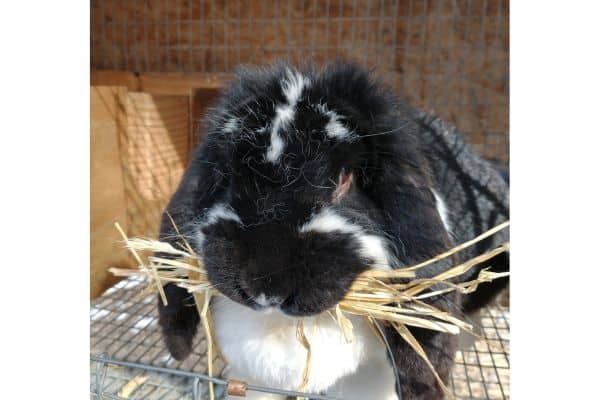
Labor Signs Before A Rabbit Gives Birth
If you didn’t have an accidental breeding you should have a ballpark of when your female rabbit is due. Rabbit gestation is typically 31 days. But pregnant rabbits not kindling (giving birth) until 33 days is not unheard of.
48-72hrs BEFORE delivery: You will start to notice this with time and experience but it will look like the doe’s belly has “dropped”. Just like a human’s muscles get loose this is their body’s way of getting ready for delivery.
It will look like there is a space between the rabbit’s belly and her lower back. See the image below. You can almost see a separation.
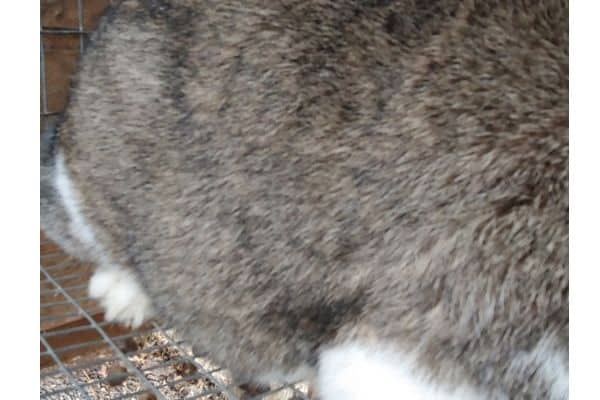
24 hours before delivery: The doe will eat A LOT and then seem to stop eating. Often you will find half of her food from the remaining day still in her bowl from the day before. This is one reason why I feed once a day at the same time every day.
12-24hrs before delivery: Some does will start nest building and pull fur ahead of time. Sometimes it’s just a few sprigs and other times it’s quite a lot. But if your doe has not done that don’t stress too much. It’s not uncommon for the doe to not pull fur until delivery.
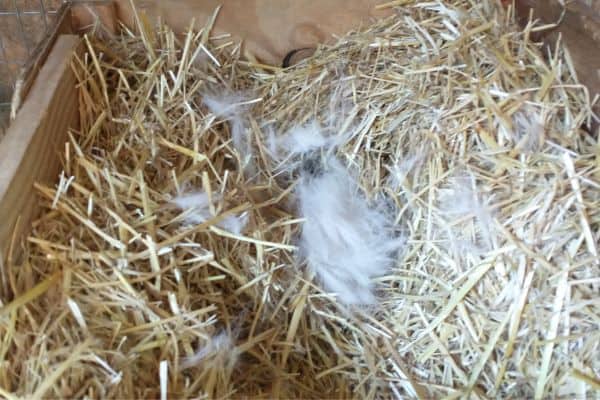
Babies Coming Any Time: If your doe is up and about looking stressed, oftentimes rustling in the nest box and pulling loads of fur. You know the babies are coming anytime. Just don’t be surprised if it still takes a few hours for all of the babies to come. Sometimes it’s one right after the other and other times it takes a few hours.
Pro tip: If she has not pulled a lot of fur and the babies have arrived you can pull some from her underbelly and this should trigger her to pull more.
How To Care For The New Baby Bunnies
After the doe has given birth you can peak in the nest and make sure that all the kits are alive and covered up in the fur. If there are dead its make sure to remove them from the nest.
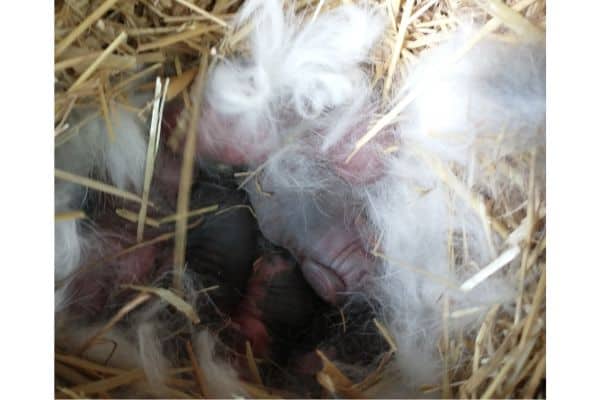
Yes, you can touch the kits. The doe will not kill them if she smells you on them.
Do make sure to keep an eye on her when you check them because even if she trusts you under normal circumstances she may come at you if she thinks you are annoying her babies.
I will often feed the doe to distract her when I want to check the kits. After she settles down and the babies are a few days old the does tend to chill out a bit.
Feeding New Born Rabbits
Baby rabbits will nurse for the first two weeks after birth then around 2.5-3 weeks they are starting to be weaned pretty quickly. I will often offer a very small amount of pellets to the rabbit litter if they are still in the nest box around 2.5 weeks of age because if you have a proper nest box and the rabbits can’t get out you don’t want them getting hungry because the doe has started to transition them to solid foods.
If the kits are solid on their feet and they are doing fine on the wire I turn the nest box on its side so the kits have somewhere to hide but they can still get out to get fresh food and clean water.
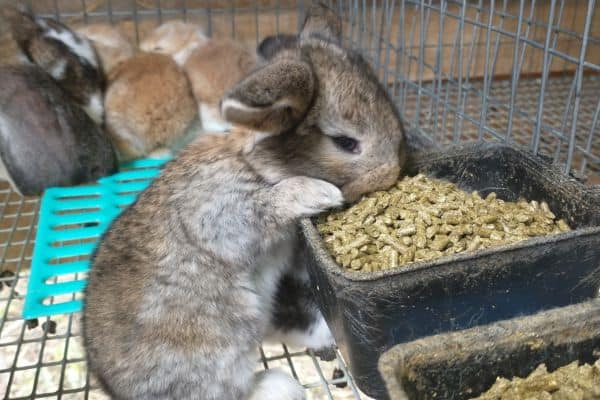
Changing The Nest Box Material
You want to make sure the nest stays dry. You may have to change the bedding around day 5 after the kits are born if it gets messy. A bit of turds is not wired but the moisture is the main concern. Once you add the clean bedding try to save as much of the dry fur as possible and add it back to the nest.
Get help and find motivation as we build our intentional backyard farm together.
Make sure to have a plan for the baby rabbits. They grow up fast and you don’t want to leave them together too long. Siblings will start to fight each other typically around 12 weeks old but I have had does as young as 9 weeks break skin.
If you need help creating a strategy for your backyard farm this guide will help you do that.
Think about the lifestyle you want to live and the work involved in doing that. Plan a budget around your farm goals to make sure you don’t cause stress unintentionally.
Rabbits Giving Birth FAQ’s
How Long Does It Take For A Rabbit To Give Birth
If we are talking from the first signs of labor pains to delivering all of the babies. It could take just a few hours to as long as a day.
Ideally, you don’t want to see a rabbit in labor for more than 24hrs or you could run into some kits being born dead.
Do Mother Rabbits Stay With Their Babies At Night?
No, the mother rabbit doesn’t stay with her kits at all. She comes to feed them and leaves. They are prey animals and the doe doesn’t stay close to the nest so she doesn’t attract the attention of predators.
What Is It Called When A Rabbit Gives Birth?
When a rabbit is giving birth it is called kindling.
Do Rabbits Give Birth To All Babies At Once?
Some rabbits will give birth to another kit just a minute or two after the last one. BUT that is not always common. It could take as long as another hour before the next kit is born.
But if it has been more than a 12-24hr period since the last kit was born and the doe does not look like she has settled down. Then she may have a kit stuck.


